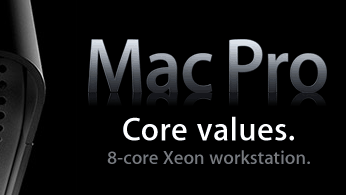Apple bursts out with 8-core 3 GHz Intel quad-core


Server manufacturers like HP, IBM, Dell, and Fujitsu aren't far behind, and they will soon be releasing their 3 GHz quad-core dual-socket servers. While Intel's quad-core CPUs are hundreds of dollars more expensive than AMD's dual-core CPUs, the cost of the CPU is only a small part of the total system cost. In some cases, it can even be less expensive if a customer opts for a single quad-core CPU instead of two dual-core CPUs. That also decreases the costs due to power consumption because a single quad-core CPU will always be more efficient than two dual-core CPUs. This means Intel is able to offer dual-socket servers at roughly half the price of a quad-socket AMD server with nearly the same performance. The other major factor to consider is that most Enterprise software vendors charge by the socket and not by the number of CPU cores. By trimming the number of CPU sockets in half, customers can easily save $100,000 per CPU socket that isn't used.
AMD isn't standing still, and it's trying to release its own quad-core CPU, code-named "Barcelona." The chip will probably launch in July of this year, but that puts it eight months behind Intel's quad-core offering. AMD's marketing strategy for dealing with this deficiency has been to say that its quad-core chip will be a "native" quad-core and that Intel's quad-core is merely two dual-core CPUs stuffed into a single CPU package. The problem with that argument is that customers don't really care how they get four cores in a socket so long as they're being charged less money for software licensing, they're paying less for servers with fewer sockets, and they're getting the performance of four CPU cores out of a single CPU. AMD seems to be in agreement with this assessment when its executive vice president, Mario Rivas, stated, "If I could do something different, I wish we would have immediately done a MCM - two dual cores and call it a quad-core."
While AMD is praying for Barcelona to make up for its time lost, time doesn't seem to be on its side. AMD had been promising that Barcelona -- when it comes out -- will beat Intel's quad-core 2.66 GHz Clovertown, but Intel doesn't seem to want to sit still and wait for AMD to regain the lead. With the release of the 3 GHz quad-core CPU, Intel has significantly raised the bar so that AMD will most likely fall short on dethroning Clovertown on Integer performance in the mainstream dual-socket market. Barcelona will, however, take the Floating-point performance lead. But that's useful only for certain scientific workloads, which doesn't benefit most business applications.
Intel will most likely be releasing another update before or during the launch of AMD Barcelona with a jacked-up front side bus at 1600 MHz, up from the current 1333 MHz front side bus. That memory performance boost isn't without power consumption penalty, though, and it does mean that the memory will drain even more power. Intel's usage of FB (fully buffered) memory already means that every DIMM will take an extra 4.5 watts, compared to the kind of memory AMD systems use. Jacking up the FSB will mean even more power being used in the memory for Intel-based servers, unless Intel finds some way to reduce the power consumption of the buffers. This means that despite losing the overall performance advantage, AMD's Barcelona may at least regain the performance/watt advantage on most workloads. AMD doesn't use FB memory and it doesn't need to jack up the memory clock because of AMD's integrated memory controller and Hypertransport architecture.
AMD's integrated memory controller and Hypertransport architecture is what allows AMD to scale multi-core performance so perfectly, and it's keeping AMD in the game as far as four-core and eight-core performance goes. Intel currently blasts AMD on single- and dual-threaded performance, which is why it dominates the gaming benchmarks. But Intel's massive single-thread lead is cut down to a slight edge by the time you get to eight CPU threads. Intel plans to rectify this situation in the second half of 2008 with its next CPU architecture, code-named Nehalem, which uses its own integrated memory controller. AMD, on the other hand, hopes to close the manufacturing gap at around the same time by going to a new wet lithography 45 nm process. It's going to be interesting to see who comes out on top as this seesaw battle continues.